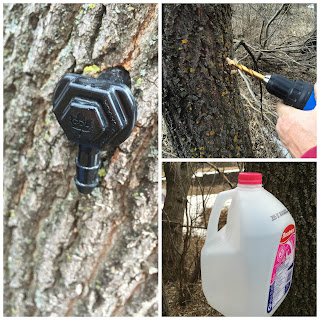 What
a crazy spring for seeding! Many farmers were active in the field or even
finished seeding before May even began. I myself was quite warry of frost and therefore
stuck to my original schedule. It definitely paid off because we experienced a
freezing night or two in the middle of the month. Since we haven’t received any
rain in May until recently, nothing has come up yet. The garden was getting
really dry which makes germination really difficult even with additional
watering. I’m glad we got a few inches of rain this week to really kick things
into gear. I love seeing all the trees go from baron branches to lush and
flowering in many spread out stages (also good for the bees!).
What
a crazy spring for seeding! Many farmers were active in the field or even
finished seeding before May even began. I myself was quite warry of frost and therefore
stuck to my original schedule. It definitely paid off because we experienced a
freezing night or two in the middle of the month. Since we haven’t received any
rain in May until recently, nothing has come up yet. The garden was getting
really dry which makes germination really difficult even with additional
watering. I’m glad we got a few inches of rain this week to really kick things
into gear. I love seeing all the trees go from baron branches to lush and
flowering in many spread out stages (also good for the bees!).The plants that I started indoors within the beginning of April are now at a decent size to transplant. I nailed the timing and watering strategy this year which yielded plants not too big (which are unwieldly) or small (which tend not to survive transplanting). The week of April 1st turned out to be a great week to start. As for watering, I had the 3’’ pots lined inside trays that held water. I watered the bottom of the trays and not the top to avoid a seedling disease called damping off that causes high mortality rates. In the next couple of weeks after the plant has clearly established itself, it’s better not to water too often so that you encourage root formation, but not too little in that the plant wilts. I have struggled with this for the past couple of years so it’s feels great to finally get it right. The plants are now hardening off outside because they are used to their warm cozy lifestyle indoors. Without slowly ‘’hardening off’’, the change in environmental conditions could cause severe wilting, sunburn, stem breakage or outright death. They need to be outside just during the day for 4 – 7 days and then outside all day and night for another 4 -7 days to accustom them to the sunlight concentration and fluctuating temperatures. It has been difficult to keep them outside for consecutive days due to high winds and rain, but they will be transplanted soon enough to hopefully reward me with early tomatoes, peppers, eggplant and brussel sprouts!

I started seeding and transplanting my other vegetables and fruit on May 5th and finished on May 22nd. Taking advantage of which crops can be seeded earlier or later based on their optimum germination temperature spread out the planting season for me. Cooler crops like peas, spinach, kale, and bare root raspberries and strawberries went in the first couple of weeks of May. Seeds planted mid-May included the majority of row crops like lettuce, onions, potatoes, brassicas, carrots, grain crops and herbs. The last crops to be planted were the warm season crops like corn, beans, melons, cucumbers and squash. I’ll also be trying to plant the sweet potato slips this week alongside the transplants. It seems as though all of my winter planning paid off; yielding a stress free planting season.
This year we also got 8 more hive packages in the beginning of May. This brings us to a total of 16 hives which hopefully will be split into 20 in the next week or two. The older hives from 2014 and 2015 are massive and healthy with big bee populations coming out of the winter which is great to see! The hives that are 2 years old had their queens replaced to keep production at maximum and all hives are now medicated and ready to go. Hiving the new hives was also successful with my dad and brother being a invaluable help. The next step is to look out for the dearth period coming up in which all spring flowers are done producing and summer flowers haven’t started yet. Other than feeding and hive splitting, the next month should be fairly low maintenance in terms of beekeeping.




















